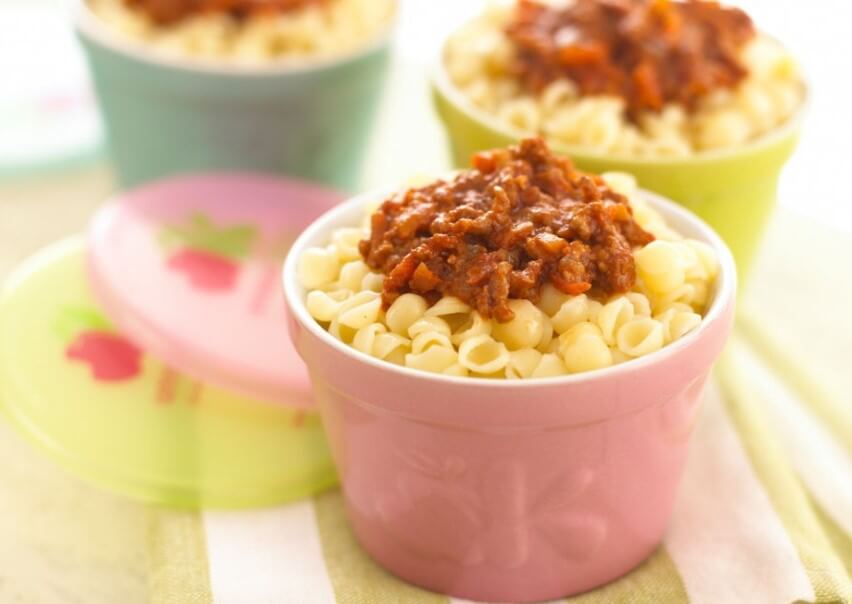weaning baby recipes for weaning the baby month by month. Weaning is one of the most important phases of its development and growth, the beginning of its relationship with new foods, so it should be done well, without haste, and with the advice of the pediatrician.
What does “wean” mean?
Weaning is moving a child from breastfeeding to feeding in other ways. Weaning is a process that requires patience and understanding, both on your part and on the baby’s part.
The weaning baby recipes is a major step in its development and growth, so you should do it right, unhurried. To help you, we compile a selection of recipes for weaning baby recipes the baby month by month.
Before starting weaning baby recipes, it is advisable to have the advice of the pediatrician, who will guide the parents in a fundamental step in the baby’s development. Month by month, the pediatrician will indicate the foods that can be introduced into the baby’s diet, to make it more and more varied and complete.
Top secrets of weaning baby recipes
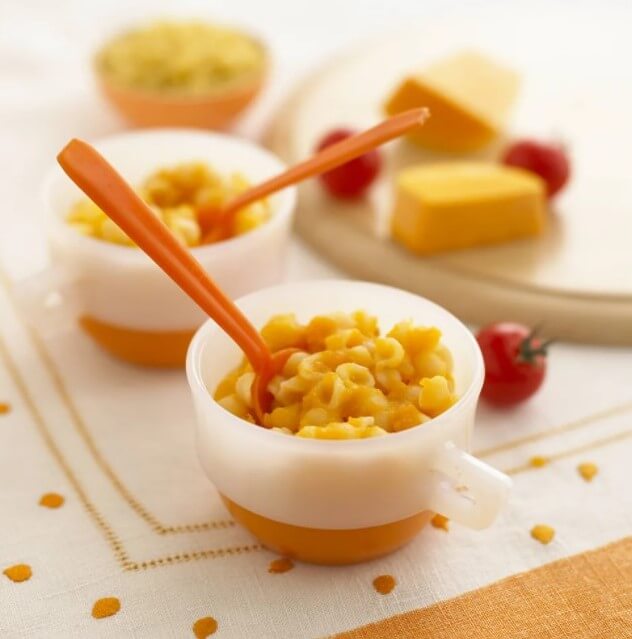
Starting to give your baby the porridge is an important step in their growth and feeding. involves beginning weaning and the introduction of new foods progressively. Therefore, we offer you the 10 secrets of weaning baby recipes: weaning baby recipes
1. When are foods other than milk introduced?
• If the child is breastfed, he will be ready for the first porridge around six months . On the other hand, if he is fed with formula milk, he can start from the four months of age.
2. What foods enter your diet first?
• It is usually started with fruit because, thanks to its naturally sweet taste, it is easier for the baby to accept it. But, in reality, nothing would prevent you from starting with vegetables, also digestive and light, such as carrots, potatoes and zucchini (boiled or steamed with a drizzle of olive oil).
3. What are the first cereals given to the child?
• You should start with cereals that do not contain gluten , such as rice, corn, millet or sorghum. After the first tests, the quantity can be increased gradually, introducing the semolina and the soup pasta, small in size. In any case, cereals containing gluten (especially wheat) should not be introduced before six months.
4. When can you start giving the baby two purees or porridges a day?
• In general, the first porridge that is introduced is the one at noon, once a month has elapsed from the start of the complementary feeding , the daily purees are increased to two, and the evening meal is also introduced.
5. Is meat essential?
• Meat, which can be introduced from 6-7 months , is an excellent food for growth, but it is not essential. It is a magnificent source of “noble” proteins (rich in essential amino acids that the body is not capable of producing alone), and provides a considerable amount of iron.
6. What are the advantages of homogenized jars?
• During the introduction of new foods, industrial jars represent an excellent option. Being homogenized, they are very digestive and are easily preserved for a long time.
7. When is cow’s milk introduced?
• From three years of age: before this age, the child’s intestine is still not able to properly assimilate the nutrients in cow’s milk. Experts recommend giving grow-out milk to children one to three years old, as it has more iron and vitamins than cow’s milk, but is less protein.
8. What if the little one is thirsty?
• During the introduction of new foods, the child should drink plenty. In fact, with purees, you increase the waste load that the kidney must destroy, and the water helps you in this job.
9. What is the best time to introduce the fish?
• Fish is one of the foods that cause the most allergies in children. For this reason, its introduction is delayed until 8-9 months. To start with, you can opt for the homogenized jars, or for the fish that are easier to clean, such as sole, hake or whiting.
10. How to insert the eggs?
• Eggs are another of the foods that carry a high risk of allergy. What gives more problems is the white, which is why you start with the yolk, offering the child a small amount (a teaspoon), added to the puree, around 9-10 months. The amount is then increased little by little, and it is offered to the child a couple of times a week. At one year of age, the egg white can also be offered, well cooked, since the heat attenuates the allergenic properties and facilitates its digestion.
Read also: baby scrambled eggs
Signs that the baby is ready for weaning baby recipes
Some children want to breastfeed indefinitely. But others signal their moms to let them know that they are ready to begin the weaning baby recipes process. These signs may include the following:
- seem disinterested or upset when nursing
- take less time than before to feed
- being easily distracted while nursing
- “play” on the chest; for example constantly pulling on the nipple or biting it (if a baby bites during breastfeeding, you should immediately remove it from the breast and say calmly but firmly: “Do not bite. Bites hurt”)
- suck for comfort (suckles at the breast but does not express milk)
Types of foods in the seventh month of the baby
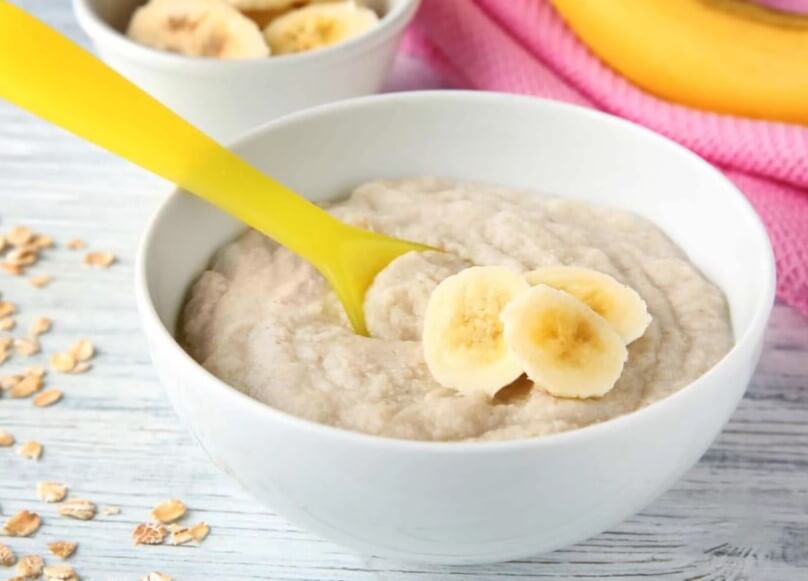
According to the specialists of the National Institute of Pediatrics, it is essential to know the type of food, the amount and the frequency with which they should be given depending on the age of the baby.
In the sixth month of the baby, weaning baby recipes begins and the first semi-solid foods are introduced. The INP recommends testing each new product on its own and in a small quantity to rule out any intolerances or food allergies.
The first recommended foods are vegetables and fruits, rich in vitamins and minerals, such as carrots, squash, bananas or apples, always prepared in purees or porridge. The amount will be between one and two small tablespoons once or twice a day, better in the morning, and gradually increasing the variety and the amount as the month passes. Do not forget to keep breastfeeding or formula milk.
First recipes for weaning baby recipes: your first puree
The vegetable puree is one of the first courses that will test the baby. It is a very simple recipe to prepare: a carrot, an onion, a small zucchini and a ripe tomato. Cut the vegetables and cook them over low heat. In this way, you will get a vegetable cream that will be very easy to take.
You can add a handful of whole grains (15 grams) without gluten to this puree or season with a few drops of extra virgin olive oil. This vegetable puree or cream is excellent for the first weeks of weaning baby recipes.
Little by little, other foods will be introduced, such as adding boiled or steamed meat (30-40 grams of chicken, turkey, veal or rabbit) to the puree, as well as rice (about 20 grams) or a tablespoon of cheese. Avoid salt during the baby’s first year of life.
Recipes for baby’s first meals
- Cream of corn and tapioca with cheese : To prepare this recipe we need cream of corn and tapioca (2 tablespoons), cottage cheese (20 grams), water (500 ml), a zucchini, a carrot, a small potato and a teaspoon of oil of olive. First the vegetables are washed, peeled and diced, to cook for 30 minutes. Separate the vegetables from the broth, and pass them through the blender. From the cooking broth, take a cup and add the cream of corn and tapioca, cooking for 5 minutes. Pour in the vegetable cream and add the cheese and olive oil. Mix well.
- Cream of rice with pear: The ingredients are cream of rice (2 tablespoons), pear juice (500 ml), a zucchini, a carrot, a small potato, olive oil. The vegetables are first washed, peeled and cut. Cook them in water for half an hour. Then filter the broth and, with the vegetables, puree in the blender. We booked. From the broth, take a cup and add the cream of rice, cook it for 5 minutes. Add the pear juice and mix with the vegetables and olive oil.
- Green bean puree: The ingredients are green beans (100 grams), a teaspoon of cheese and a teaspoon of extra virgin olive oil. Wash and clean the green beans, removing any grain or thread. We cut them and steam for 10 minutes until they are tender. We filter the water and pass the beans through the blender until we get a cream. Then add the cheese and mix well. Finish with a few drops of olive oil.
Tips for baby’s diet
From the sixth month onwards, cheeses can be introduced into the baby’s diet, although it is better to always opt for fresh cheeses , avoiding excess fats or fermented ones. From the seventh month the baby can start taking egg yolk, fish and ham. Up to 12 months it is advisable to avoid foods such as tomatoes, citrus fruits or egg whites. From the sixth or seventh month, in the snack you can start to introduce a yogurt (light) or a smoothie.
Baby recipes from the sixth month
From the sixth month, and gradually, we will introduce food into the diet of the smallest in the house. Here is another selection of recipes, easy to prepare:
- Cream of rice with trout: The ingredients are cream of rice (2 tablespoons), trout (steamed), a zucchini, a carrot, a small potato and olive oil. First, peel and wash the vegetables well. They are cut into small pieces and cooked for 30 minutes. Next, filter the broth and prepare a puree with the vegetables. In a cup of broth, add the cream of rice and cook for 5 minutes. Remove from the heat and, in a bowl, add the vegetable cream, the trout (use only the meat, shredded) and the olive oil. Fish, and trout, in particular, contain Omega 3 fats, essential for the nervous system.
- Cream of rice with pumpkin: The ingredients are pumpkin (300 grams), 2 tablespoons of cream of rice, a teaspoon of Parmesan cheese and a teaspoon of olive oil. Cut the pumpkin into small pieces and cook for an hour. Filter the broth and pass the pumpkin through the blender. In a cup of the leftover broth, add the cream of rice. Next, mix with the pumpkin cream and olive oil.
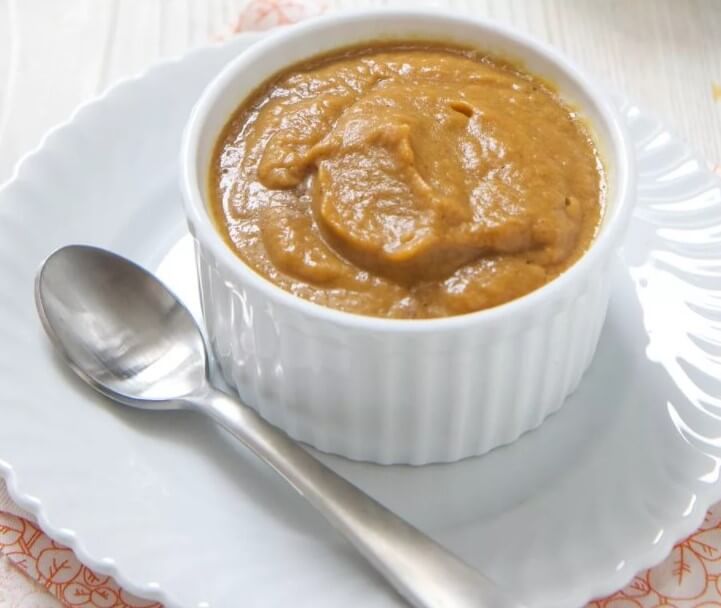
Baby diet: food month by month
What are the foods that can be included month by month? From the fifth month on, babies can eat soup and vegetable puree, rice, corn and tapioca flour, fresh cheeses, fruits (pears, apples), cookies, gluten-free cereals, vegetables. They will progressively eat meat and fish. From 10 months they can already eat legumes. Also, take note of solid foods to avoid.
Types of foods in the seventh month of the baby
From the seventh month of the baby’s life, cereals and some tubers can begin to be introduced into the diet, since they have great energy and vitamin contribution. It is recommended rice, corn and potatoes, the former can be mixed with milk or baby food and purees.
Regarding the amount, it remains the same as the previous month, one or two small tablespoons once or twice a day. In addition, the type of fruits and vegetables can be increased, depending on the season.
Do not forget that these first months you must be patient with your little one, especially when he rejects some food. You can mix this product with other flavors or textures, and also take advantage of seasonal foods, always fresh and natural.
Don’t miss: The best spices for baby
Recipes for babies 4 to 6 months
Do you have a baby of 4 to 6 months and your pediatrician has advised you to start the introduction of foods other than milk? Do you need recipes for babies from 4 to 6 months because you don’t know what ingredients to start with? Don’t worry, we have compiled for you the best recipes for babies from 4 to 6 months:
healthy, tasty and nutritious recipes, with the right ingredients to start complementary feeding the best way and make the baby know new flavors that will be part of his diet and that, little by little, will be introduced with different textures, as he grows and accepts the new flavors.
Of course, before starting the introduction of foods other than milk, or offering your 4 to 6-month-old baby any new food, you should consult your pediatrician, and strictly follow his instructions regarding the feeding of your little one.
Feeding your baby is one of the pillars of your health and well-being: it plays a decisive role in the proper functioning of your body and enables its development and growth: a correct and balanced diet can prevent disorders and diseases, such as anemia, constipation, vitamin deficiency, infantile alopecia and a long etcetera.
Pear and apple compote recipe
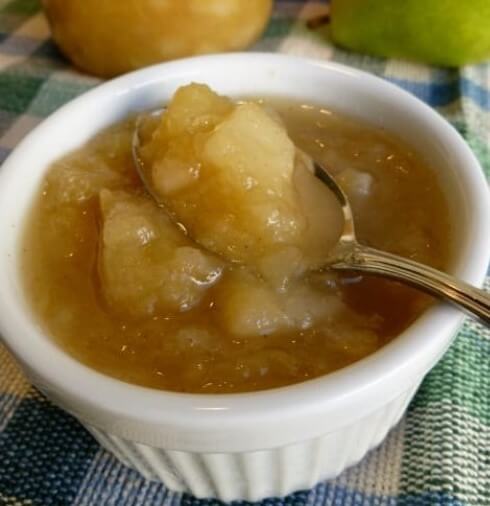
The first fruits that the pediatrician normally recommends introducing into the baby’s diet, around four to six months of age, are apple, pear and banana. The reason? They are easy to digest fruits, with a pleasant texture for the baby, with a low risk of causing allergies or intolerances to the child and with a mild and sweet taste, which is usually well accepted by children.
Other fruits, on the other hand, such as peaches, strawberries or tropical fruits, should be introduced in the complementary feeding of the baby later, usually until after one year of age, depending on the pediatrician’s indications, since they present more risks of intolerances and flavors and textures that are more difficult for the baby to accept.
Fruits, such as apple, pear or banana, should be given to the baby, during the first weeks of the introduction into his diet, in the form of purees, porridges or as compote, very beneficial for the child. Next, we offer you a rich and simple recipe for apple and pear compote, with a very sweet and appetizing flavor for your child.
Ingredients
– 500 grams of pears
– 500 grams of pippin apples
Preparation
- First of all, to make the apple and pear compote, you have to wash, peel and cut the fruit into small pieces, removing the core from the pears and apples.
- Next, cook the fruit in a saucepan over low heat and let its juice reduce.
- Then boil for approximately 20 minutes, stirring the compote from time to time.
- After cooking, pass through the masher and put back on a very low heat.
- Increase the intensity of the fire and bring to a boil for a couple of minutes.
- To finish, remove from heat, pour the mixture into individual glasses and let the compote cool before serving.
Benefits of apple and pear compote
Both apples and pears are two very healthy fruits that, presented to the baby in the form of compote, offer a sweet and appetizing flavor while preserving all their properties and nutrients. The apple and pear compote is very beneficial for children’s health because it provides antioxidants, flavonoids and vitamins .
Of all the possible compotes, apple is the best known and the first that is given to the baby to taste, when the first fruits are introduced into their diet, between four and six months of age, depending on the pediatrician’s indications. Apple compote, which can be accompanied by other fruits, such as pear in this case, is very good for the baby for the following reasons:
- It provides a high intake of vitamin C . Responsible for strengthening the body’s defenses, vitamin C reduces cellular aging and the damage caused by free radicals in the body.
- Helps fight constipation. The compote Apple provides a lot of fiber to the body, which makes it an ideal dish for those babies who suffer from constipation since it can improve and end it.
- Allows you to regain your appetite. If the baby has trouble eating or is sick, applesauce is ideal to regain his appetite.
Fruit cream recipe

The introduction of new foods in the baby’s diet usually begins between four and six months of age with the since, thanks to its sweet taste, it is more easily accepted by the child. Although some parents are in favor of introducing solid and uncrushed foods into the baby’s diet, most choose to start with crushed foods in the form of purees and porridges. The texture of the puree is more pleasant for the child and allows him to start in adult feeding gradually.
On the other hand, when the baby begins with complementary feeding, he should not stop the usual milk intakes. Some pediatricians advise that, during the first month of the introduction of new foods in the child’s diet, it is enough to give him a puree a day and keep the milk intakes, since he is still an infant.
Ingredients
- 1 piece of fruit (apple, pear, banana).
- 3 tablespoons of milk followed.
Preparation
Peel the chosen piece of fruit, remove the seeds, bring to a boil and mash. Mix the fruit porridge with three tablespoons of milk then.
Recipes for babies 7 to 9 months
If you have a baby from 7 to 9 months and you still don’t have much experience preparing recipes suitable for their age, we offer you many suggestions of recipes for babies from 7 to 9 months that will delight your little one. Thanks to our filter, you will be able to select the type of dish and food, and, automatically, you will have dozens of healthy, nutritious and very rich recipes for babies from 7 to 9 months,
to be able to vary often and, in this way, accompany the introduction of foods other than milk in your baby’s diet in a varied and entertaining way, so that neither of you get bored of the moments of the day dedicated to feeding the child. Turn mealtime into an adventure!
The recipes that we propose can also serve as a basis to prepare recipes to your liking, with the ingredients that the pediatrician has indicated, and avoiding those not recommended by the doctor, in case the baby has shown some type of intolerance or of allergy after its introduction.
Has your 7-9-month-old baby tried different foods, such as fruits, vegetables, meat or fish, but you always end up preparing the same puree for the whole week? You may not be a gourmet yet, but you can also get tired of the monotony. Surprise him with our delicious and healthy recipes for babies from 7 to 9 months!
Apple Chicken Delight Recipe
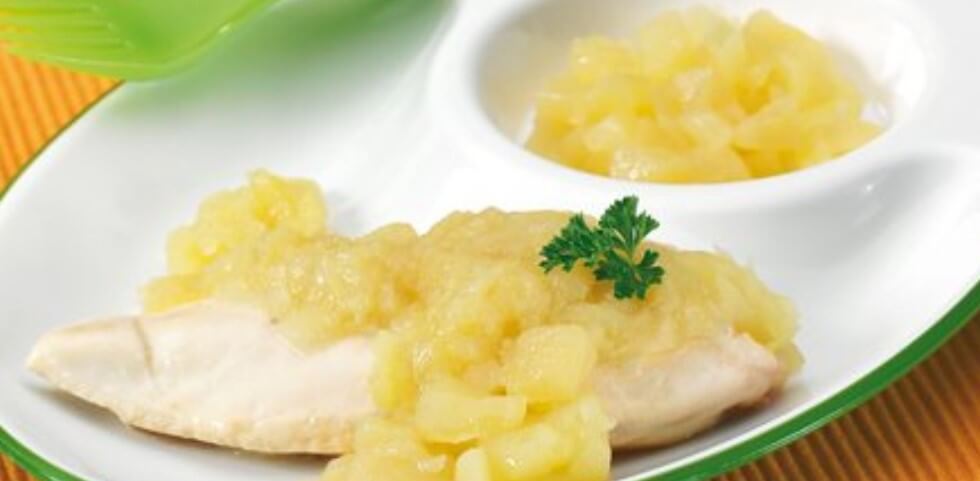
One of the first meats that are given to the baby, when he is between four and six months old, is chicken with a tender and smooth taste, a pleasant texture and easy digestion. However, it may be difficult for the child to accept the new flavor, so it is convenient to keep in mind some tricks to get her to accept it with pleasure.
This is the case of the recipe with chicken and apple for babies that we provide you below . The mixture of the nutritious meat of the chicken with the sweet taste of the apple results in an appetizing dish for the little one’s palate.
Ingredients
– 30 g of chicken breast
– 1/2 apple
– 1 tablespoon of virgin olive oil
Preparation
- To start, peel and chop the apple, removing the core and seeds.
- Once peeled, steam it for about 20 minutes.
- Next, grill the chicken breast and cover it with the apple, which we will have previously crushed with a fork.
- If the child still cannot tolerate the pieces, crush the breast before mixing it with the apple.
- Finally, season the dish with the virgin olive oil.
Is it better to give the child organic fruit?
Organic fruit is very beneficial, since babies and young children are especially sensitive to the harmful effects of foreign chemicals . The reasons for this greater sensitivity are several: the smaller the body surface area, the greater the toxic action of the chemical residues; synthetic chemicals are all the more dangerous the faster the growth rate of cells (much faster during childhood than in adulthood); In the case of newborns, the still immature organism finds it more difficult to eliminate toxic substances.
Organic foods have a higher level of antioxidants and have lower levels of toxic metals and pesticides than foods grown with conventional methods.
Recipes for Babies 10-12 Months
If you have a 10 to 12 month old baby , you are already an expert in culinary matters, because your little one has already tried many and varied foods, and his diet is beginning to resemble that of the rest of the family. For this reason, we are delighted to offer you hundreds of recipes for babies from 10 to 12 months, a selection of dishes designed specifically for babies and children of this age, who are halfway between the classic baby diet and the diet of babies. greater.
In this stage, the task of parents consists, in addition to offering their baby the food they need to grow and develop strong and healthy, to introduce their little one to the gastronomic world other words, vary, offer you different flavors and textures, present food in different ways, and bring you closer to the culture and gastronomic customs of your area.
In addition, sitting at the table with the rest of the family, they begin to establish healthy habits and education at the table, which should be consolidated in the first years of life, especially, with the introduction into a more social environment, such as dining room of the nursery school, for example.
Pasta recipe with Brie cheese and basil
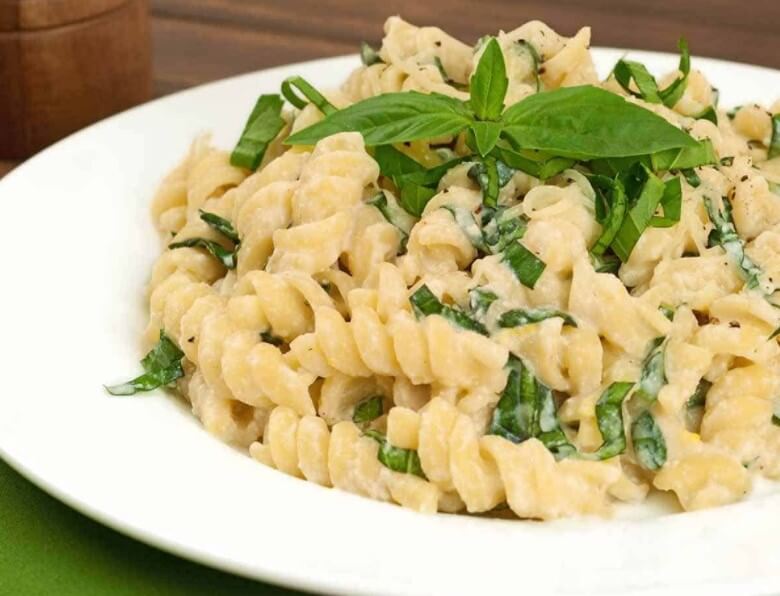
Starting at 10 to 12 months of age, the baby can already eat a lot of food. In fact, it is during this age that he begins to get used to solid food textures, always served in small pieces and easily chewy to avoid choking. It is, therefore, the ideal time to include in their diet one of the star foods of children: pasta, which they like so much and gives them so much energy.
The recipe for pasta with Brie cheese and basil that we show you below is especially designed for babies between 10 and 12 months of age, since it is easy to chew, tasty and very nutritious, rich in carbohydrates, but also in proteins, since the cheese contains high amounts.
Ingredients
- 250 g of pasta (“spirals”).
- 300 g of brie cheese.
- 150 ml of liquid cream.
- 1 sprig of fresh basil.
- Salt.
- Pepper.
Preparation
- Pour the cream with the chopped basil leaves, salt and a pinch of pepper into a bowl and mix well.
- Remove the outer layer of the Brie cheese and cut it into small cubes.
- Cook the pasta in plenty of salty water until it is tender, but whole (al dente).
- Drain it well and put it in a bowl.
- Add the cheese cubes and mix quickly until they have melted.
- Add the cream and basil sauce, mix it again and serve immediately.
When to introduce pasta into the baby’s diet
Pasta is a food that usually fascinates the little ones in the house and, possibly, it will become one of your child’s favorite foods from the moment they taste it for the first time. But, when to introduce pasta in baby recipes?
Ideally, and always following the pediatrician’s recommendations, is to do it once the eighth month has passed, when the little one begins to get used to slightly lumpy consistencies, less smooth than those of creams.
Green Vegetable Puree Recipe
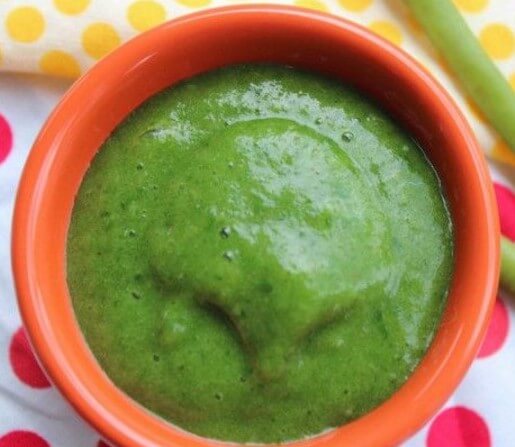
The first vegetable purees are usually introduced into the baby’s diet between four and six months of age, depending on the pediatrician’s instructions.
Later, when the child is between 7-9 months old, he can eat all kinds of vegetables in the form of purees and porridges . In this period of growth of the child, it is important to introduce in their diet foods that provide all the necessary nutrients to develop in a healthy way. Among the vegetables, the green leafy ones stand out, with many properties and benefits.
Ingredients
- 50 grams of floury potatoes.
- 100 grams of spinach, broccoli, zucchini and fennel.
- 20 grams of lamb’s lettuce.
- 2 or 3 tablespoons of apple juice.
- 1 teaspoon of olive oil.
Preparation
- To start, wash and peel the potatoes, vegetables (spinach, broccoli, zucchini, fennel) and lamb’s lettuce.
- Then cut them into pieces; and break the lamb’s lettuce into smaller pieces.
- Boil the vegetables covered with a little water for about 15 minutes to soften them.
- Then add the lamb’s lettuce and blend them with the blender.
- Finally, add the apple juice and the olive oil and go through the blender again.
Green vegetables: healthy and very beneficial!
Green leafy vegetables, such as spinach, chard, broccoli, lamb’s lettuce, celery or arugula, are very beneficial for the body, as they have a high content of vitamins A, C, B and E, and are rich in minerals, such as calcium, iron, magnesium and potassium. Something that characterizes them all is the green color, which indicates that they are rich in chlorophyll, which purifies the blood and facilitates the elimination of toxins from the body.
In addition, the presence of chlorophyll in green leafy vegetables favors cell regeneration, which allows strengthening the immune system through the production of red blood cells.
Kisses for all!!
If you liked this recipe you can contact us on buzzrecipes.com and you will receive new recipes in your email.
weaning baby recipes

